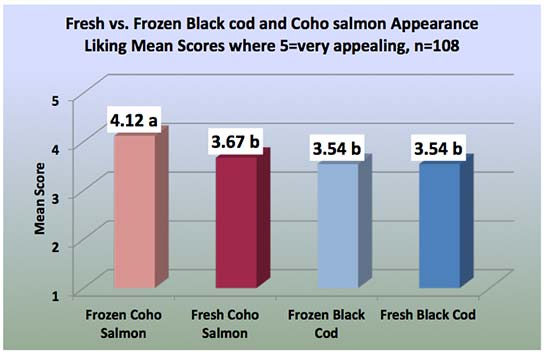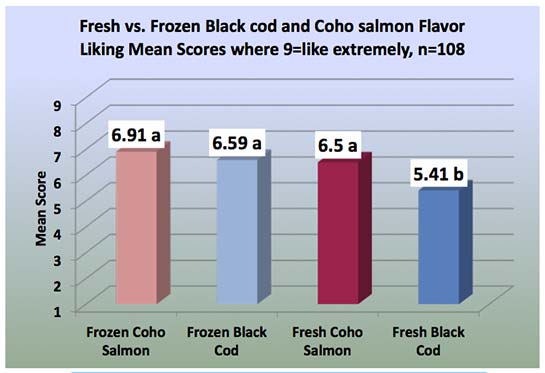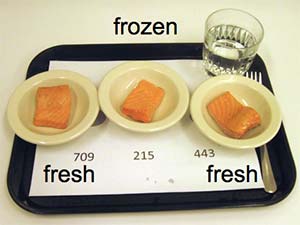By John Saulnier, FFB Editorial Director
The test scores are in and, not surprisingly to FFB readers, frozen fish are at the head of the class!
 This was the consensus among participants in a sensory science survey conducted to determine if consumers could tell the difference between frozen and fresh presentations of coho salmon and black cod. The results were detailed at Seafood Expo North America in Boston on March 21 by Ann Colonna, sensory and consumer program manager at the Food Innovation Center in Portland, an off-campus Oregon State University (OSU) experiment station.
This was the consensus among participants in a sensory science survey conducted to determine if consumers could tell the difference between frozen and fresh presentations of coho salmon and black cod. The results were detailed at Seafood Expo North America in Boston on March 21 by Ann Colonna, sensory and consumer program manager at the Food Innovation Center in Portland, an off-campus Oregon State University (OSU) experiment station.
Joining Colonna in the session, entitled “Understanding Consumer Perceptions of and Preferences for Fresh-Frozen vs. Fresh Fish,” was Keith Cox, Ph.D of Seafood Analytics’ Juneau, Alaska-based science research office. He is an expert in bioelectrical impedance analysis (BIA), which determines seafood freshness by measuring feedback from electrical currents applied to fish that instantly provide data regarding cellular degradation.
 Dr. Keith Cox talks about the misconception among consumers who believe so-called “fresh” seafood is superior to flash frozen fish. Listening to his comments is Ann Colonna of Oregon State University’s Food Innovation Center, which conducted a study on that very subject.Dr. Cox organized procurement of marine products for the OSU evaluation. The quick-frozen samples were randomly selected from freezing plants in Alaska, while so-called “fresh” fish (which in fact were likely to have been out of the water for five or six days prior to purchase) was sourced from high-end grocery stores in Portland.
Dr. Keith Cox talks about the misconception among consumers who believe so-called “fresh” seafood is superior to flash frozen fish. Listening to his comments is Ann Colonna of Oregon State University’s Food Innovation Center, which conducted a study on that very subject.Dr. Cox organized procurement of marine products for the OSU evaluation. The quick-frozen samples were randomly selected from freezing plants in Alaska, while so-called “fresh” fish (which in fact were likely to have been out of the water for five or six days prior to purchase) was sourced from high-end grocery stores in Portland.
The Seafood Analytics co-founder and vice president of scientific development pointed out that up to one-quarter of “fresh” fish – that is to say, fish defined by the FDA simply as “never been frozen,” rather than describing a state of quality – is thrown away by retailers and foodservice operators concerned about food safety as the clock ticks down on “sell by” dates.
“My family eats exclusively frozen fish, rarely fresh, unless it has been caught on the day it will be consumed,” said Dr. Cox. He added that the degradation of non-frozen fish, which has a relatively short shelf life, begins rapidly after landing.
Fish Analytics knows this in precise terms, as its Seafood-CQR hand-held device technology garners quantitative data that includes quality remaining shelf life, and whether the product subject to examination was ever frozen. This information can be used, from catch to consumption, to make shipping decisions and product trajectories. But the most important thing is that needed data is delivered quickly and consistently to ascertain the status of fish along its natural decomposition timeline.
OSU Findings
 The OSU study of 146 consumers, funded by a grant from the National Fish and Wildlife Foundation, found that while those surveyed said they buy more fresh than frozen seafood, results from blind taste tests showed that they perceived the quality of frozen as superior to fresh in many instances.
The OSU study of 146 consumers, funded by a grant from the National Fish and Wildlife Foundation, found that while those surveyed said they buy more fresh than frozen seafood, results from blind taste tests showed that they perceived the quality of frozen as superior to fresh in many instances.
All persons surveyed (38 were subjected to “difference testing,” while 108 were involved in “acceptability testing”) were frequent purchasers of fish, with 75% of the group buying coho salmon two to three times or more per month, and 50% generally purchasing black cod two to three times or more monthly.
Key demographic identifiers of those surveyed are as follows: 66% female; 41% reported pre-tax household income of $80,000 to $120,000 or more per year, while 37% were in the $40,000 to $79,999 bracket, and 22% had income of up to $39,999; 47% of the sample surveyed for “difference” was 18 to 35 years old; about half of all participants had a four-year or higher college degree.
Materials and Methods
Frozen fillets were received a few days prior to testing and thawed in a refrigerator at a temperature of 36°F, while “fresh” fish was purchased on the morning immediately before afternoon testing. Fillets were skinned, portioned in 1.5 oz pieces and baked for approximately three to four minutes at 145°F.
Triangle testing involved the serving of three samples, of which two were either frozen or fresh and the third was not. Consumers asked to select the “different” sample” made correct determinations in 22 out of 38 instances in Test 1, and 21 out of 38 times in Test 2. In such scenarios the odds are one in three that a right “guess” will be made regardless of sensory perception.
“For black cod, flavor and texture were the main drivers, with appearance being much less significant,” said Colonna. “For coho salmon, again flavor and texture were the main drivers at 37%. Appearance accounted for only a 3% perceived difference.”
Acceptability Test
In the separate monadic acceptability test, consumers were served samples one at a time and asked to rate how much they liked the products. Their response:
- Appearance. Frozen coho salmon was more appealing, while black cod samples rated identically in appearance liking.
- Aroma. Both fresh coho salmon and black cod smelled “fishier” than did the frozen samples.
- Overall Reaction. Both frozen black cod and coho salmon were liked more than the fresh samples.
“Frozen coho salmon scored better than fresh, but statistically the result was the same. Frozen black cod scored much higher than fresh,” said Colonna. “As for moisture content, fresh was perceived to be too moist, and black cod was closer to ideal…Frozen black cod rated highest, with people saying they would definitely buy frozen over fresh.”


Among comments about frozen black cod made by samplers: “Taste was clean and subtle. Texture was a nice consistency. It’s a delicious piece of fish.”
 When asked about frozen coho salmon likes and dislikes, some of the replies were: “Perfect texture, tastes great! Nothing to dislike. This is my favorite by far. I’d push my kids to not drown this in tartar sauce. Overall, a nice piece of fish!”
When asked about frozen coho salmon likes and dislikes, some of the replies were: “Perfect texture, tastes great! Nothing to dislike. This is my favorite by far. I’d push my kids to not drown this in tartar sauce. Overall, a nice piece of fish!”
Fresh-Frozen Fresher than ‘Fresh’
Upon providing survey participants an information sheet about frozen seafood and quick freezing, Colonna was told by many recipients that they were “not aware of the advantages of flash freezing,” and did not know that “flash freezing hold nutrients better.”
While it may be preaching to the choir of FrozenFoodsBiz.com readers, the high points of the information disseminated by OSU’s sensory and consumer program manager are worth repeating. So we will do so:

“Frozen seafood, when handled correctly, is of higher quality than most never-frozen ‘fresh’ fish on the market. Flash freezing refers to a process by which objects are frozen very quickly – often only a few hours after harvest – by subjecting them to temperatures well below water’s freezing point. Flash freezing is used in the food industry to quickly freeze perishable food. Rapid freezing reduces the size of ice crystals, causing less damage to cell membranes. Flash freezing locks in the freshness and quality of a fish the day it was caught and processed – whereas many fresh fillets may have been in the grocery seafood display case for eight days or more. In fact, most ‘sushi-grade’ fish has been previously frozen in order to kill bacteria and parasites. Frozen fish also offers more flexibility to consumers, who can defrost as needed instead of worrying they have to use it or lose it.
“Nevertheless, many consumers perceive frozen seafood to be a cheaper, lower quality product and often expect to pay less. This creates a very real market barrier for small-scale commercial fishermen with lower volume fisheries who need to meet a higher price margin to remain viable.
“Flash frozen seafood addresses significant economic challenges facing domestic small-scale fishermen such as seasonal swings in volume, distribution cost, and more accurately matched supply and demand, thereby generating much less waste. Freezing allows small-scale fishermen to participate in and develop markets for underutilized species, thereby increasing resource utilization without increasing fishing intensity. And freezing provides a buffer against seasonal flooding of small-boat fishermen’s core markets.
“Flash frozen seafood has environmental benefits as well. If product is driven a reasonable distance to market its relative environmental impact is low. However, most fish consumers live far from where the fish is caught, and the majority of fillets they buy are never frozen and shipped by air, which is the world’s most carbon-intensive form of travel. But contrast, frozen fish can be moved thousands of miles by container ship, rail, or even truck with a much lower carbon footprint.
“By increasing consumer acceptance of frozen seafood, consumers can have a broader range of carbon-friendly, sustainably harvested domestic seafood with a far longer shelf life…”
Now that’s good food for thought!
Hats off to Ann Colonna, Keith Cox and the team at OSU’s Food Innovation Center for their work in objectively examining consumer perceptions and preferences for fresh-frozen vs. non-frozen fish products. Meanwhile, Phase II of the study has been launched to find effective ways to best communicate the benefits of frozen seafood products to consumers.
Complete survey results may be obtained by e-mailing a request to: ann.colonna@oregonstate.edu




